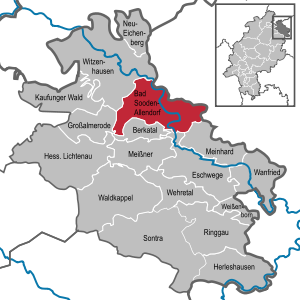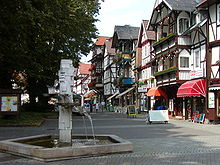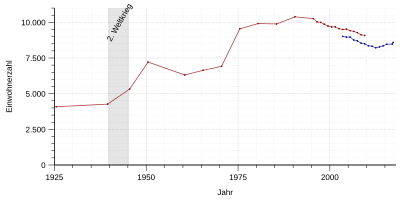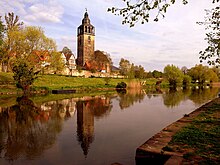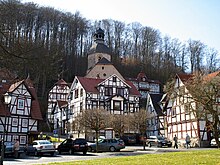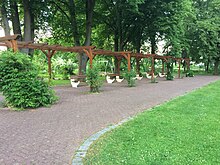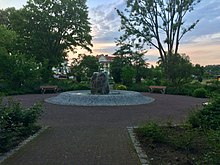Bad Sooden-Allendorf
| coat of arms | Germany map | |
|---|---|---|

|
Coordinates: 51 ° 16 ' N , 9 ° 58' E |
|
| Basic data | ||
| State : | Hesse | |
| Administrative region : | kassel | |
| County : | Werra-Meißner district | |
| Height : | 162 m above sea level NHN | |
| Area : | 73.52 km 2 | |
| Residents: | 8631 (Dec. 31, 2019) | |
| Population density : | 117 inhabitants per km 2 | |
| Postal code : | 37242 | |
| Area code : | 05652 | |
| License plate : | ESW, WIZ | |
| Community key : | 06 6 36 001 | |
| LOCODE : | DE BH2 | |
| City structure: | 10 districts | |
City administration address : |
Marktplatz 37242 Bad Sooden-Allendorf |
|
| Website : | ||
| Mayor : | Frank Hix ( CDU ) | |
| Location of the city of Bad Sooden-Allendorf in the Werra-Meißner district | ||
Bad Sooden-Allendorf is a town and a health resort in the Werra-Meißner district in northern Hesse .
geography
location
Bad Sooden-Allendorf is located directly on the border with Thuringia and almost in the geographical center of Germany . It is located on the Werra to the northwest of the Gobert ridge near the Hohen Meißner to the southwest . To the southeast, near the Kleinvach district, above the river, is Rothestein Castle .
Neighboring communities
Bad Sooden-Allendorf borders in the north on the communities Lindewerra , Wahlhausen and Asbach-Sickenberg , in the east on the communities Wiesenfeld and Volkerode (all in the Thuringian district of Eichsfeld ), in the south on the community Meinhard , the city Eschwege and the community Berkatal , im West to the city of Großalmerode and to the northwest to the city of Witzenhausen (all in the Werra-Meißner district).
City structure
In addition to the core town of Bad Sooden-Allendorf, the city consists of the districts of Ahrenberg , Dudenrode , Ellershausen , Hilgershausen , Kammerbach , Kleinvach , Oberrieden , Orferode and Weiden . The core city itself consists of Sooden and Allendorf, with Sooden on the western side of the railway line.
history
The place has existed since at least the end of the eighth century. This is evidenced by a deed of donation by Charlemagne , King of the Franks , which historians dated between 776 and 779. With this document, Karl transferred the salt springs, salt pans, salt workers, market, tribute and customs of the Westera settlement to the Fulda monastery . The name of the settlement refers to its location on the western border with Thuringia .
The Roman historian Tacitus left an even older document that does not refer to the settlement, but to the location. According to his report, chatting and Hermunduren are said to have quarreled over salt springs on a border river. The border river was the Werra, and historians believe the sources were those under what is now Sooden.
During the Thirty Years' War , troops moved through from 1623 under the generals Johann T'Serclaes von Tilly , Wallenstein , Jean de Merode and Gottfried Heinrich zu Pappenheim . Each time they collected occupation costs and sold letters of protection so that the city would not be set on fire. The coffers of the city and its citizens were empty when the Croatian regiments Geleen and Isolani invaded in April 1637 and set the city on fire on April 27th. The church registers do not record any deaths from the fire, because the citizens were able to save themselves through connecting doors between all the cellars in the city. But in the same year 141 of them died, because when they lived in the cellar vaults after their return, the plague broke out. Sooden was not burned because the saltworks were under the protection of the landgrave. Only the foundation walls remained of Allendorf.
Many carpenters were needed for the reconstruction, more than could be found in the area. So colleagues traveled from Lower Saxony, Thuringia and the rest of Hesse. The three typical half-timbered styles can be found in the city today. The Rathof - built entirely of stone - survived the great city fire and has been preserved as the oldest building in the city. Until 1821, Allendorf was the main town of the Hessian office Allendorf , which in that year became part of the newly formed Witzenhausen district.
For more than 1000 years, until the end of the 19th century, salt was extracted from brine in boiling houses . The brine was extracted from a deposit under the city. The abolition of the salt monopoly as a result of the annexation to Prussia in 1866 led to a drop in prices, which led to the abandonment of salt production. The last salt was extracted in 1906.
At the same time as the saltworks went down , the healing properties of the brine were discovered and the construction of a bathhouse began. On June 1st, 1881 the house was inaugurated and handed over to its intended use. With the Seehofer's health reform in the 1990s, however, the number of cures also collapsed; meanwhile the city relies on tourism.
Even today, the fountain festival, which takes place every year at Whitsun, is a reminder of the time when salt was extracted. A true-to-original pan demonstrates how salt was extracted in the past. The salt is then sold in a salt museum; the history of salt production is also presented there.
In 1853, the world's first industrially manufactured cone bag was made by the paper manufacturer Gumpert Bodenheim on the town's market square .
Allendorf and Sooden were forcibly united on July 1, 1929 to form Bad Sooden-Allendorf. Sohten, later Sooden (location of the salt works ), was until then only a place where the saltworkers lived in the Middle Ages, while Allendorf, the seat of the rich owners of the boiling pans , had already received town and market rights in 1218.
modernization
- At the turn of the millennium, the graduation tower was dismantled and completely rebuilt. The reason was the rot of the brushwood, on which the brine drips down. As an open-air inhaler, the building had become indispensable for tourism.
- Werratal thermal baths
- At the end of 2005 a thermal bath with a large sauna area was completed in order to attract private paying guests to the city. The brine exercise pool was converted for this purpose.
- Culture and congress center Werratal
- In April 2007 a new event hall for congresses and concerts was opened at the location of the old hall.
- Play golf course
- In 2010 the mini golf course, consisting of lanes made of Eternit plates , was removed and replaced by a modern play golf course .
- Traffic calming
- The road layout has also been changed. Since then there is no longer any direct connection between Sooden-Nord and Sooden-Süd; car traffic has to switch to the bypass through the industrial area. The station is being dismantled and modernized on two tracks; from there a direct route to Sooden is to be created. With these measures, the city wants to counteract the decline in the spa business insofar as the area around the thermal baths and the spa area becomes easier to reach and a car-free zone.
Incorporations
In the course of administrative reform in Hesse until then independent municipality Ahrenberg was on a voluntary basis on September 1, 1970 incorporated . On January 1, 1972, Dudenrode, Ellershausen, Hilgershausen, Kleinvach, Oberrieden, Orferode and Weiden were added. Kammerbach followed on January 1, 1974 by virtue of state law. For each of the nine incorporated districts, a local district with a local advisory council and a local mayor was set up.
Development of the population
The city published the following population development on its website until 2009 (values in brackets), and from 2003 the values of the Hessian State Office for Statistics:
|
|
|
|
Debt
Like many municipalities in Germany, Bad Sooden-Allendorf is pushing a mountain of debt in front of it. At a city council meeting at the end of October 2011, Mayor Frank Hix described the situation as “dramatic” and “bottomless pit” - the budget for 2012 including the business plans for the company's own businesses and the investment program up to 2015 were introduced. For 2012, Hix expected a budget deficit of twelve million euros and total debt of 80 million euros. Due to the high level of debt, the city council voted in December 2012 with 17 votes to 5 with 9 abstentions for participation in the municipal protective umbrella program of the State of Hesse. Bad Sooden-Allendorf was thus one of the first municipalities in the Werra-Meißner district to use the so-called protective shield. By using the protective screen, the city should be relieved of around 18.8 million euros in debt. In addition, Mayor Frank Hix expected a further allocation of around 20 million euros from the state compensation stock. By using the protective screen, the city committed itself to an austerity program as well as to increasing taxes and duties. In search of new sources of income, the municipality broke new ground and introduced a horse tax for the first time in early 2013 . In December 2018, an application by the FDP parliamentary group to suspend horse tax did not find a majority in the city council. Abolition is planned for the years from 2021, when the city has fulfilled the requirements of the protective shield. A corresponding motion finally found a majority in the city council in March 2019. This vote was likely due to the fact that the annual tax income of around EUR 18,000 was lower than the initially expected EUR 30,000. In addition, the city of Bad Sooden-Allendorf lost a process at the Kassel Administrative Court at the beginning of the year. Accordingly, the city is not allowed to levy horse tax for eight horses of a club, since the requirements of the horse tax statute are not met.
politics
City Council
The local elections on March 6, 2016 produced the following results, compared to previous local elections:
| Parties and constituencies |
% 2016 |
Seats 2016 |
% 2011 |
Seats 2011 |
% 2006 |
Seats 2006 |
% 2001 |
Seats 2001 |
||
|---|---|---|---|---|---|---|---|---|---|---|
| CDU | Christian Democratic Union of Germany | 36.6 | 10 | 37.0 | 12 | 36.8 | 11 | 32.7 | 10 | |
| SPD | Social Democratic Party of Germany | 32.0 | 9 | 36.9 | 11 | 41.8 | 13 | 38.8 | 12 | |
| GREEN | Alliance 90 / The Greens | 12.9 | 3 | 16.5 | 5 | 9.1 | 3 | 9.5 | 3 | |
| FWG | Free community of voters | 12.0 | 3 | 6.1 | 2 | 7.6 | 2 | 10.0 | 3 | |
| FDP | Free Democratic Party | 6.5 | 2 | 3.5 | 1 | 4.7 | 2 | 5.9 | 2 | |
| REP | The Republicans | - | - | - | - | - | - | 3.1 | 1 | |
| total | 100.0 | 27 | 100.0 | 31 | 100.0 | 31 | 100.0 | 31 | ||
| Voter turnout in% | 50.0 | 51.4 | 53.9 | 55.4 | ||||||
mayor
Frank Hix (CDU) has been mayor of the city since March 5, 2009. In the mayoral election on September 28, 2014, he received 2,680 votes (70.1%) as the incumbent mayor, while his opponent Jens Richter (SPD) received 1,141 votes (29.9%). The turnout was 57.0 percent.
The current and former mayors of Allendorf (until the merger with Sooden in 1929) and of Bad Sooden-Allendorf (from 1929) are or were:
- Frank Hix (from 2009)
- Ronald Gundlach (March 1997 to 2009)
- Erich Giese (1991 to 1997)
- Rolf Jenther (1984 until resignation in 1991, shortly after re-election)
- Rolf-Erich Barié (1978 to 1984)
- Gerhard Harke (1960 to 1978)
- Fritz Franke (April 1946 to 1960, provisional since September 1945)
- Wilhelm Siebert (June 1945 to September 1945)
- Fritz Haase (April 1945 to June 1945)
- Cornelius Bents (January 1945 to April 1945)
- Ferdinand Schneider (May 1930 to December 1944)
- Karl Eulert (August 1925 to April 1930)
- Karl Leimbach (December 1923 to July 1925, City Treasurer / Acting Mayor)
- Adolf Müller (January 1898 to December 1923)
- Georg Ludwig Oeste (June 1877 to July 1897)
- Hugo Jesse (January 1874 to May 1876)
- Otto Heinrich Kroeschell (1853 to 1873)
- Christian August Seyl (1834 to 1852)
- Lorenz Heinrich Stephan (1808 to 1813, no mayor, but mayor during the Westphalian era)
The following list contains the names of the families who held the mayor's office in Allendort before the 19th century - around 1400; it does not claim to be complete and, as there are no dates, it is in alphabetical order:
Brandt, Breul, Casselmann, Body / Corper, Deichmann, Diede, Dietz, Dörr, Eschstruht, Frohn, Gaule, Gehrung, Gille, Grau, Grebe, Grunewald, Gundlach, Haas, von Haagen, Hupfeld, Guardian, Iring, von Jossa, Isenhuth, Kirchmeyer, Klinkerfuß, Königsee, Kraft, Kröschell, Lappe, Lutemann, Marold, Mattenberg, Meinhard, Jost Motz (around 1620), Müller, Neuenroth, Niedenstein, Geissler Praesendt (around 1585), Preacher, Quentel, Ruland, Saame, Schaffnicht, Heinrich Schaub (around 1440), Schmidt, Schnödde, Stephan, Storm, Thaurer, Tholde, Thorey, Valentin, Vielmeder, Vietor, Wagner, Weber, Wehr, Wissenbach, Wolff.
For about 200 years, until it was united with Allendorf, Sooden was an independent municipality (Sooden was first referred to as such in a document from 1711). The last mayor of Sooden was called Zeeden, but today we mainly remember Hedwig Lange (1876 to 1901), as he founded the spa.
City arms
| The coat of arms approved by the State Archives in 1931 shows a crenellated circular wall with a gate tower and four inner towers, silver with blue roofs (old coat of arms of Allendorf). In the archway on a red background a diagonally crossed pan hook and a Berlaff (wooden spoon to accelerate the brine evaporation) in gold (old Sooden coat of arms). |
Partnerships
Bad Sooden-Allendorf maintains partnerships with the cities
- Landivisiau in Finistère, France since 1974
- Bad Frankenhausen in Thuringia since 1990
- Krynica-Zdrój in Poland since May 21, 2010
Culture and sights
Museums
- The museum stands directly on the former death strip on the border between Hesse and Thuringia. In addition to old border installations and a number of historical military vehicles and helicopters, it houses a clear and detailed history of the inner-German border.
- The salt museum in Söder Tor is a reminder of the town's almost 1000-year history of salt.
Buildings
- Lookout tower on the Roßkopf
- Well in front of the gate
- Possible place of origin of the known song . Early on - because the city's softest water springs from there - a nearly 1,000-meter-long wooden pipe was laid from the source on the Zinnberg to a Kump in front of the southern city gate. In 1218, when the city became a town, a linden tree was planted next to it . Probably in the 18th century a time stick was set up there. The trade route from Frankfurt to Lübeck ran right next to the linden tree, the fountain and the Zeitstock . It has been suggested that the Dessau-born poet Wilhelm Müller saw this ensemble on a trip and was thus inspired to write his poem Der Lindenbaum . Built in 1827 Time Stock is obtained, which formerly built Kump is still original, the Linde hand, was replanted in 1912, rebuilt the gate 1997th
- Thief storm
- Watchtower built in the 14th century as part of the city fortifications. In 2000 it was given a new roof and is now used as a lookout tower.
- It was demolished and rebuilt from autumn 1999 to summer 2002. Because of the salty air, which is beneficial for the respiratory tract, it is a popular place for relaxation, which the locals call "Our vertical North Sea".
- Holy Spirit Chapel
- Historic half-timbered old town
- Rothestein Castle
- St. Crucis Church
- St. Mary
- Werratal thermal baths
- Thermal bath with brine, sauna, outdoor area. A quarter of the graduation tower is integrated into the sauna area.
- Klausberg Tower
- An earlier erected in 1400 ten-meter-high watchtower on the eastern city of 288.1 m above sea level. NHN high Klausberg, which is now used as a lookout tower.
Parks
- Spa park with swan pond
Regular events
Bad Sooden-Allendorf is known nationwide for the harvest festival and festival , which is celebrated every year around the third weekend in August (Friday to Tuesday). It is particularly popular because of its many traditions - it has been celebrated with the same program for over 100 years. Highlights:
- Torchlight parade followed by a tattoo and lighting (Werra in flames)
- Big pageant on Sunday
- The city is richly decorated with garlands and harvest crowns made of grain, mainly done by the residents themselves
- Spanish fricco food
- Street festival in the old town (Friday), entertainment mile on the fairground (Saturday to Tuesday)
- Triolett -Tanzen, a dance of two of three couples
In 2008 an anniversary harvest festival was celebrated, which was not the 150th, but 150 years earlier (1858) it was first organized by an innkeeper named Beuermann. The local artist Martin Schülbe documented the preparations and the festival and published a DVD that is available in various shops in the city.
Every year in the week after Easter, the fairy tale week takes place in Bad Sooden-Allendorf. Numerous events, for example fairy tale evenings and theater performances, introduce visitors to the world of fairy tales, framed by daily appearances by fairy tale characters in the spa gardens. The focus is on Ms. Holle , who is said to have lived on the nearby Hohe Meißner and shakes the beds in the historic Söder Tor every day. The 15th fairy tale week took place from 12. – 19. April 2009. For the first time, a medieval market was included in the event. The 20,000 visitor mark was exceeded.
In addition, the Fountain Festival takes place on the Whitsun holidays, which Johannes Rhenanus initiated as early as the 16th century in gratitude for the “beneficial brine springs ”, making it the city's oldest festival.
tourism
Bad Sooden-Allendorf is a stage on the Werra-Burgen-Steig Hessen (X5H) long-distance hiking trail .
Economy and Infrastructure
education
With the primary school Am Brunnen vor dem Tore (grades 1 to 4) and the Rhenanus school (grades 5 to 13), Bad Sooden-Allendorf offers the opportunity to complete a full school career without moving or daily trips. The Bad Sooden-Allendorf sports boarding school is integrated into the Rhenanus School and has produced a number of well-known athletes since it was founded in 1971. The pupils do not end their school career with a "sports diploma", but with the general university entrance qualification, since this school is not a sports high school but an additive comprehensive school .
The location of the Diploma University ( Bernd Blindow Group ) is also located in Bad Sooden-Allendorf .
Business world
The local business world is concentrated both in the pedestrian zone "Weinzeile" in the Sooden district and in Kirchstrasse in Allendorf's old town. There is also an industrial area that houses the four largest supermarkets in the city; In each district there is also a further, smaller supermarket in the vicinity of residential developments.
In addition to a few hotels, the large number of private guest houses, especially in the Sooden district, is worth mentioning.
Clinics
Various clinics have settled in the city, which is also a health resort.
- Balzerborn Clinic
- Here, patients with rheumatic, renal and orthopedic diseases as well as patients in the professional association inpatient further treatment (BGSW) with a focus on occupational therapy and workplace-related rehabilitation are treated.
- Sonnenberg Clinic
- Hoher Meissner Clinic
- Clinic Kurhessen of the German Pension Insurance Hessen
- Specialist clinic for respiratory diseases, diseases of the skeleton, muscles and connective tissue, dermatology, allergology and heart diseases.
- Specialist clinic for orthopedics, rheumatology and neurology.
- Clinic Werra of the German Federal Pension Insurance
- She specializes in musculoskeletal disorders, behavioral orthopedics and psychosomatic medicine.
- Werraland Clinic
- Describes itself as the "Center for Family Health". Dedicated to rehabilitation and prevention of mental and somatic diseases. In addition, diseases of the musculoskeletal system, respiratory diseases, allergies and skin diseases are treated.
media
- The Witzenhäuser Allgemeine, a local edition of the HNA ( Hessische / Niedersächsische Allgemeine ), appears as a daily newspaper .
- In addition, the MB-Media-Verlag, which also belongs to the HNA (Ippen-Neffe Schöningh) via the Ippen Group, publishes two weekly newspapers called Marktspiegel and Extra-Tipp , which are less about regional topics than tabloid reporting.
- The BSA-Kurier is an advertising newspaper for the local Kurpark-Hotel, whose advertisements were also recently acquired by the HNA. Local club reports and cultural announcements found a place in it.
- A city leaflet is published by the Linus-Wittich publishing house for a few subscribers.
- Furthermore, the local radio station RundFunk Meißner (RFM) can be received in the city, which takes its name from the nearby mountain Hoher Meißner .
traffic
- Bad Sooden-Allendorf is connected to the motorway network via the B 27 Witzenhausen - Eschwege .
- The central station is on the north-south railway line Göttingen – Bebra - Fulda .
- There is a city bus system operated by the Eichsfeldwerke .
- The nearest airport is Kassel-Calden Airport .
- The Werra cannot be used for large ships. But there is a lot of traffic with paddle boats.
- A mobile home port near the old town and Werra attracts caravans.
- A network of hiking and cycling trails is available.
- Bad Sooden-Allendorf is on the German Fairy Tale Route , which leads from Hanau via Bad Sooden-Allendorf to Bremen.
Personalities
Sons and daughters from Bad Sooden-Allendorf
- Burkard Waldis (around 1490–1556), fable poet , playwright and Shrovetide author
- Johannes Gottsleben (around 1559 / 1560–1612), Protestant theologian in the age of the Reformation
- Bernhard Textor (around 1560–1602), Reformed theologian
- Johann Siegmund Kirchmayer (1674–1749), Protestant clergyman and professor at the University of Marburg
- Johann Wilhelm Krafft (Ioannes Guilielmus Krafft) (1696–1767), Reformed theologian
- Ferdinand von Wintzingerode (1770–1818), nobleman and officer in various armies, most recently general in the Russian army
- Ludwig Rehn (1849–1930), surgeon
- Gerhard Ritter (1888–1967), historian
Personalities who worked or lived in the place
- Theodor Fabricius (around 1501–1570), Lutheran theologian and reformer
- Johannes Rhenanus (around 1528–1589), salinist , theologian , alchemist and author
- Eva von Buttlar (1670–1721), sectarian
- Johann Christian Kirchmayer (1674–1743), Protestant theologian and professor at the Universities of Heidelberg and Marburg
- Georg Thieler (1854–1945), lawyer and mayor of Jena (1885–1889)
- Wilhelm Speck (1861–1925), writer, poet, Protestant pastor, prison chaplain and educator
- Hermann Metz (1865–1945), painter and draftsman
- Herbert Mager (1888–1979), painter
- Sigurd Lohde (1899–1977), actor
- Ruth Baldor (1899–1988), actress and voice actress
- Manfred Lückert (* 1947), author on Thuringian and Hessian history
- Björn Höcke (* 1972), politician, until 2014 sports and history teacher at the Rhenanus School
literature
- Adolf Reccius: History of the city of Allendorf in the Soden (contributions to the history of the Werra landscape, issue 3). Bad Sooden Allendorf (City of Bad-Sooden-Allendorf, self-published) 1930, illustrated (and city map of Allendorf from 1745/46), 152 pp.
- Erich Hildebrand (edit.): Land to Werra and Meißner - A home book. Bing-Verlag, Korbach 1983, with essays by 40 authors, 384 p., Numerous. Fig.
- Udo Bernhardt, Dagmar Kluthe: People between Werra and Meißner. [Large-format picture and text volume, 110 pages] Eschwege 1997
- Manfred Lückert: Bad Sooden-Allendorf, Eschwege and the surrounding area. Historical photographs 1926–1966. Bad Sooden-Allendorf 1997, 168 p., 291 fig.
- Peter Aufgebauer : Allendorf and the beginnings of Hesse in the 13th century. In: Das Werraland 47 (1997), pp. 31-34 u. 59-60.
- Literature on Bad Sooden-Allendorf in the Hessian Bibliography
- Literature about Bad Sooden-Allendorf in the catalog of the German National Library
- Literature about Bad Sooden-Allendorf in the bibliographic database WorldCat
Web links
- City administration website
- Bad Sooden-Allendorf , historical context
- Bad Sooden-Allendorf, Werra-Meißner district. Historical local dictionary for Hessen. In: Landesgeschichtliches Informationssystem Hessen (LAGIS).
Individual evidence
- ↑ Hessian State Statistical Office: Population status on December 31, 2019 (districts and urban districts as well as municipalities, population figures based on the 2011 census) ( help ).
- ↑ Heinz Schmidt-Bachem (2001): Bags, bags, carrier bags: on the history of the paper, cardboard and plastics processing industry in Germany. Pp. 54–55 - with reference to the city chronicle for 1938.
- ^ Allendorfer Papierwarenfabrik GmbH. In: albert-gieseler.de. Retrieved February 13, 2015 .
- ^ Incorporation of the communities Ahrenberg into the town of Bad Sooden-Allendorf in the district of Witzenhausen on August 28, 1970 . In: The Hessian Minister of the Interior (ed.): State Gazette for the State of Hesse. 1970 No. 37 , p. 1785 , point 1676 ( online at the information system of the Hessian state parliament [PDF; 3,9 MB ]).
- ↑ Law on the reorganization of the districts of Eschwege and Witzenhausen (GVBl. II 330-21) of September 28, 1973 . In: The Hessian Minister of the Interior (ed.): Law and Ordinance Gazette for the State of Hesse . 1973 No. 25 , p. 353 , § 7 ( online at the information system of the Hessian state parliament [PDF; 2,3 MB ]).
- ^ Federal Statistical Office (ed.): Historical municipality directory for the Federal Republic of Germany. Name, border and key number changes in municipalities, counties and administrative districts from May 27, 1970 to December 31, 1982 . W. Kohlhammer, Stuttgart / Mainz 1983, ISBN 3-17-003263-1 , p. 409-410 .
- ↑ Population figures according to the city administration ( memento from December 5, 2013 in the web archive archive.today ). - Hess. State Office for Statistics ( Memento from May 23, 2012 in the web archive archive.today ), current and older figures.
- ^ Michael Rademacher: German administrative history from the unification of the empire in 1871 to the reunification in 1990. Witzenhausen district. Bad Sooden and Allendorf. (Online material for the dissertation, Osnabrück 2006).
- ↑ The state now has to help Bad Sooden-Allendorf - Witzenhausen. In: hna.de. October 30, 2011, accessed February 13, 2015 .
- ↑ Bad Sooden-Allendorf comes under the protective umbrella. December 17, 2012, accessed February 21, 2019 .
- ↑ dpa: First German municipality introduces horse tax. In: handelsblatt.com . November 23, 2012, accessed February 13, 2015 .
- ↑ Horse tax is still levied in Bad Sooden-Allendorf. December 16, 2018, accessed February 21, 2019 .
- ↑ hessenschau de, Frankfurt Germany: Bad Sooden-Allendorf abolishes horse tax again. March 26, 2019, accessed on March 30, 2019 (German).
- ^ Judgment on the horse tax of Bad Sooden-Allendorf: Club horses are tax-free. February 26, 2019, accessed March 30, 2019 .
- ^ Result of the municipal election on March 6, 2016. Hessian State Statistical Office, accessed in April 2016 .
- ^ Hessian State Statistical Office: Result of the municipal elections on March 27, 2011
- ^ Hessian State Statistical Office: Result of the municipal elections on March 26, 2006
- ↑ Hedwig in this case is the name of a man.
- ↑ Helmut Schulte, Marianne Schulte: Health resort and saltwater spa Bad Sooden-Allendorf with historical half-timbered flair in the Werra Valley in Kurhessen Part II. (No longer available online.) In: bsa.old-schulte.de. Archived from the original on March 4, 2016 ; accessed on February 13, 2015 .
- ^ Diebesturm ( Memento from August 22, 2015 in the Internet Archive ) on the website of the Verein für Heimatkunde e. V. Bad Sooden-Allendorf
- ↑ Map services of the Federal Agency for Nature Conservation ( information )
- ↑ Klausbergturm on warttuerme.de
- ^ Report of the Hessian Lower Saxony General (HNA), local edition "Witzenhäuser Allgemeine", from April 19, 2009.
- ↑ Distance learning, face-to-face and virtual studies at the DIPLOMA University. In: diploma.de. February 14, 2015, accessed February 13, 2015 .
- ↑ BALZERBORN KLINIKEN BAD SOODEN-ALLENDORF GMBH ( Memento from July 12, 2007 in the Internet Archive ) In: bad-sooden-allendorf.de
- ↑ Björn Höcke elected chairman of the AfD parliamentary group. Thuringian General, September 22, 2014

